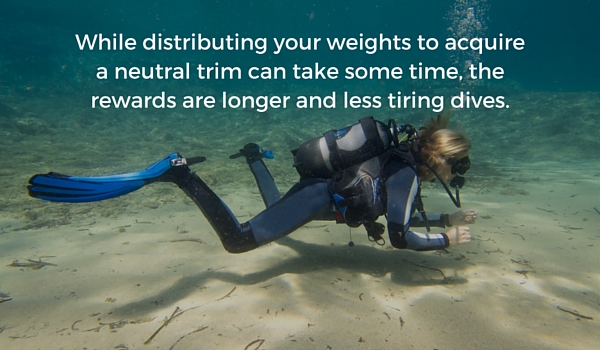Here is How You Should use Your Weights for Perfect Buoyancy
When you started your Open Water Diver (OWD) training or when you start, you were introduced to the weight belt. This simple but critical item does not get much attention in your training.
You learn that a diver and his equipment is positively buoyant, so the diver must add weight to counter it. The amount of weight varies as the equipment used, the diver’s body composition, the exposure suit used and even the water itself all affect buoyancy.
The instructor may have briefly reviewed how to estimate the amount of weight you need, and ended by saying put this on, and I will have more weights we can adjust underwater.

You quickly learned that the weights must be spaced around the belt, or you will find yourself rolling to the side. This spacing to correct your roll is one aspect of a process of being trim. The term is used in aviation as well. The pilot has to start with an approximately weight-balanced aircraft, and then adjusted various flight elements, trim, to obtain a level flight. As divers, we do something very similar.
Also read: 6 Valuable Tips To Help You Improve Your Buoyancy Control
Weight Belts
While technology has given us many advantages in scuba diving, the weight belt is still used by the majority of divers.
In its simplest form, a weight belt is a 2-inch wide nylon web belt with a quick release lever type buckle on one end. Weights are threaded with the belt and space along its length.
Variations mostly deal with using soft weights. The way we position the weights on the belt will affect our roll, however, where we position the belt around our waist or thereabouts will affect or tilt or axis.
Our body horizontal in the water will have a center of gravity (COG) which acts as a fulcrum. The buoyant weight of our scuba equipment will affect this point. If we were to draw a line through our body, this would be our line of axis.
Our goal while diving is to obtain a trim where this line is parallel to the surface. If we have more weight forward of the COG, our upward body will be lower, and we will swim in a head down alignment.
If more weight is behind the COG, our legs will be lower, forcing our chest and head up. Both of these positions will require the diver to work harder underwater because they are not streamlined.
Users of a weight belt will seldom be able to achieve a good axis with the belt alone, but it will influence what you can do. Two key points, you need to wear the belt the same way each dive and you need to keep the belt from moving.
[the_ad_group id="1249"]
Integrated Weight System
Many divers are more comfortable with an integrated system. These systems have your weights integrated into the BCD. There are four pockets, two fixed and two removable. The fixed pockets are located near the middle of the back on either side of the dive cylinder.
Two larger removable pockets are located on the lower front of the BCD where the pockets are. They are held in place by Velcro or similar material, and each has a handle that can be pulled to release it quickly. The location of the bottom weights can be moved slightly by how tight you pull the shoulder straps.
How to Balance Your Weights?
Many tech divers use a harness for their weight systems. Like grandpa’s suspenders, they are attached to a belt. Most of the weight goes into the belt or integrated weights.
Additional weights are positioned along the suspenders (harness) to provide the right balance. Recreational divers can do something similar without purchasing a harness system.
You can get weights with clips that will attach to the d-rings on a BCD, some BCD’s will have a shoulder pouch like the one on the rear. Try different weights until you find the best trim. Remember you are moving weight not increasing it. If you add 2 pounds to the D-ring, you need to remove 2 pounds from the belt or pockets.
[the_ad_group id="1250"]Quick Release
As you move weights around, remember that the weights that have a quick release must be sufficient to give you positive buoyancy if you drop them. If you are using an integrated weight system, remember the back weights are not releasable in an emergency.
While distributing your weights to acquire a neutral trim can take your time, the rewards are longer and less tiring dives.
What do you prefer, a good old weight belt or integrated weights? Let us know in the comments below
[the_ad_group id="1251"] This article is written by RUSHKULT, the online booking platform for Scuba Diving. Visit the RUSHKULT platform to book your next Scuba Dive training, guided trip, and accommodation. [the_ad id="10253"]
Leave a Comment